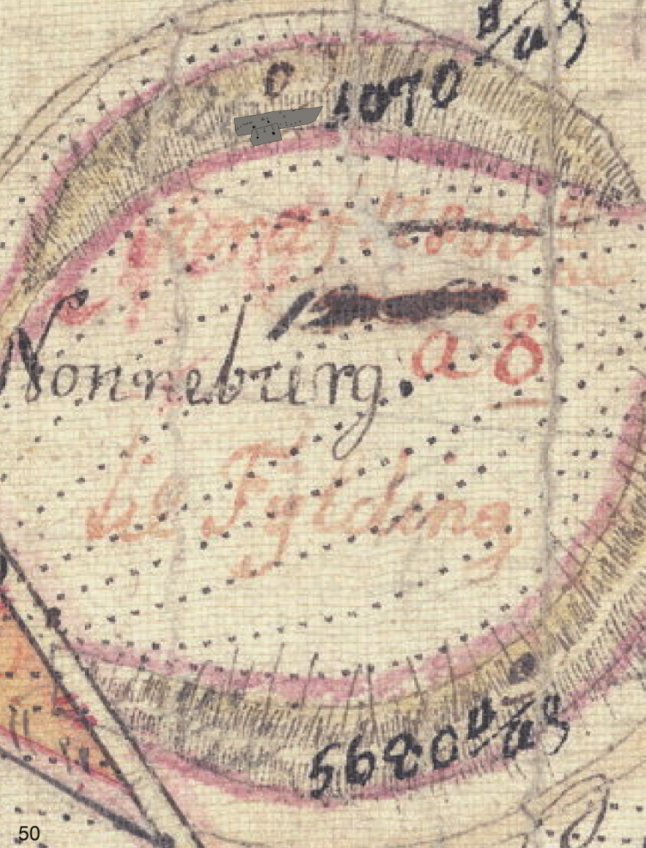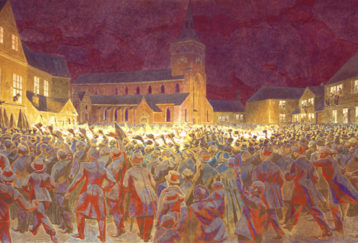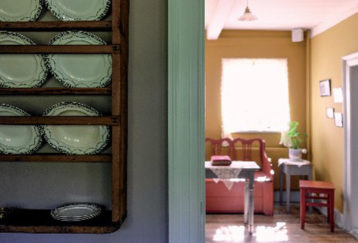
In Hans Christian Andersen’s first novel, The Improvisator, which was published in April 1835, one recognizes all the localities to which he paid a visit during his first travel in Italy. After a short stay in Florence he arrived in Rome and later on he traveled further south to Naples, the city which according to his own statement most deeply impressed him. Together with Ludvig Bødtcher and Henrik Hertz, two Danish poets from the Scandinavian club in Rome, he walked around in the city in order to see the churches, the art-galleries and watch how people lived. The confrontation with the masterpieces of the Renaissance and of the Roman antiquity impressed him to a degreee, where he felt very small and insignificant, but it also affirmed him in his belief in his vocation.
Even more than by art and history he was impressed by the surrounding nature. In the letters he wrote to his friends in Denmark he gave enthusiastic descriptions of the bright and pure colors he saw everywhere. In the second part of the Improvisator, which partly takes place in Naples, one perceives how the poet abundantly uses color adjectives in order to depict the landscape of Southern Italy. He intended to transfer the color effects of painting to literature. In one of the letters he sarcasticly compares Hertz to a calligrapher, who well knows how to write beautifully, but who is not capable of rendering the colors of the landscape.
Together with Hertz he went on a trip to the vulcano, Vesuv. During the climb the mountain was erupting, the lava was pouring out of the crater and the two Danes had an experience of hidden powers in nature, which they never forgot. In the chapters of the novel, where the poet lets the principal character, Antonio, make the same experience of the eruption of Vesuv, the number of color adjectives is very large. The hero interprets this confrontation with the flaming vulcano as an initiation in the mystery of being an artist. On the summit of the mountain he receives a revelation of God’s greatness and the beauty of nature, which releaves him of all the scruples he has nourished till then as to his future life. It seems as if especially the blue and the red color play a part: „The lava lay like gigantic, fallen stars, the moon was shining like daylight, we drove along the bay, saw the reflections of the moon and of the lava in two huge beams, one red and one blue, shivering on the surface of the water. I felt a strength in my soul, a clarity in my ideas; if I dare compare a smaller thing to a bigger one, I feel in the same way as Boccaccio did: the impression of a locality, its immediate impulse, was conclusive of all the activity of the spirit.“ (p. 188).
In the following sections of the novel, in which the hero pays a visit to the blue cave on Capri, the two colors, red and blue, constantly appear together. The blue color is not only connected with the view of the sky in Italy, but even with the extreme blue color of the Mediterranean: „Down in the surf, which was breaking like a blue fire, the blood-red sea-cucumbers grew on the rocks, having a double lustre on account of their wetness, it seemed as if the rock was bleeding each time when a wave was breaking“ (p. 230). Both the red and the blue color are used in close connection with the word ,fire‘. The greatness of the vulcano and the dim and mysterious atmosphere of the cave make an impression on him: Vesuv, red color and sensuous dreams converge in the hero’s imagination on one hand; on the other hand the blue color of the cave converges with the sea, the air and the spirit.
In a letter to Henriette Wulff, his female friend, of March 18th 1834 Hans Christian Andersen gives a humourous description of the visit to Capri: „My visit to the island was very bad, the boat nearly behaved like a toy on the big waves. The sailors could hardly get it through, it became dark and we saw a huge water-spout on the sea, I thought it was to become my tombstone“. In the novel the hero is shipwrecked, and he is flung into the cave, where he in a senseless state has a revelation. The whole passage is penetrated with feelings of despair and feebleness. Antonio awakens on a rock, over his head he perceives the blue air, his clothes are like blue flames, and the water below is blue like burning alcohol. He wonders whether this blue place is the realm of death. The blue color is shining in all shades and nuances everywhere. Near the surface of the water he sees a bright blue star, that throws a long beam across the water. Then a boat suddenly appears with the blind girl from Paestum, she has entered the cave in order to get her vision back. The poet cleverly links the old concept of the realm of death to the geographical locality — the blue cave — blending reality and myth into an airy dream, which Antonio experiences, hovering between life and death. In the old myth Eros is always represented with tied up eyes. In the same way blindness is a part of the mystery of true love, and so the heroine, Lara, regains her vision by falling in love. The mountain and the cave are like two poles in the hero’s experience of life. On the vulcano’s summit he experienced the highest affirmation of manly self-confidence, the vision of the poet as the priest of nature, closely connected with sexual fantasy. In the cave he experiences the proximity of death, despair and cold, but also a glimpse of an immortal world; the blue color is connected with an experience of something purified and elevated, a transcendental longing. In the following I should like to characterize these two phenomena as the red and the blue eros, and I hold the point of view that the two color symbols play an important part in the poet’s philosophy.
There can hardly be any doubt that Hans Christian Andersen after his first stay in Italy became so influenced by the painters in the Scandinavian and German club in Rome that he dreamt of transferring the color effects in painting to literature. After his return to Denmark he wrote in a letter: ,,You will find a description of the blue cave in my novel; professor Kruse, who is working on the translation of the book, says that I am a very great painter; Ørsted says that I should use the brush as I use the pen“ (Br. I, 289)..
Nothing indicates that the poet at first thought of using the color adjectives for any other purpose than adding some visual elements to his prose. The philosophical tradition of looking at nature as a system of fixed symbols was far from his mind. In the German romanticism the phenomena of nature for instance the sun, the moon, the stars, the rainbow and all the cosmic space – are symbols of a supernatural world. The single phenomenon is a part of a fairly coherent system of metaphors symbolizing the infinite and invisible world. In nature the German romanticists found true evidence that there was a link between the universe and the soul- and in this way they discovered the identity between the psychologically unconscious part of the poet’s inner self and the transcendentally unconscious life of nature.
This belief was clearly expressed by Oehlenschläger in Vaulundurs Saga, where he said: „Indeed, there is a highly surprising friendship between everything in nature, and why should the mind, the character and the fate of mankind be an exception from this.“ Oehlenschläger was deeply influenced by Ludwig Tieck in his first attempt to renew the fairy-tale, and in Vaulundurs Saga, which was based on a fragment in the Edda all the three colors that are connected with the three heroes have a definite symbolic impact. Andersen, however, did not belong to the first generation of romanticists. He did not come of age as a poet until the 1830s, at a time when the philosophical idealism gave way to a new realistic split in the narrative prose. Therefore one should hardly expect to find a structure of symbols in his novels. Still there is left a possibility that Andersen has made himself familiar with the use of color symbols in Italy. „While painting at last gained mastery of color in the high Renaissance, language lagged behind it in its power of chromatic suggestion and only slowly built up and standardized its vocabulary of color words“.
During the stay in Italy Andersen read Dante, and The Divine Comedy has influenced him to a large extent. The interest of the middle ages in color was evidently from the standpoint of symbolism. We find some traditional features in this, which afford a reliable starting point. Dante’s use of color is closely connected to the Catholic tradition in which he was brought up. The deductions that can be made from his colors have an exegetical and aesthetic value closely connected to the teachings of the church. In his article Heavenly Gold (Philological Quarterly vol. XII, 1933, Univ. of Iowa) H. D. Austin says: „The total number of distinguishable color-categories used by Dante hardly reaches a dozen: and the total number of times he actually employs or suggests colors as elements of his descriptions in the Divine Comedy falls short of 200. On the other hand there is a large use of the effects of light and shade, especially in the Paradiso; as has so often been noted, there are featured all conceivable degrees and varieties of brightness“.
Still I cannot believe that Andersen took over his use of color symbols from Dante. There was a popular use of color symbols in the Italian schools of painting that were taken over by European poets in the 16th century. We find it in Shakespeare’s sonnets and plays, and we find it for instance in Spenser and Jonson. All over Europe it was generally accepted that for instance yellow was the symbol of jealousy, white the symbol of innocence and green of hope and youth.
The use of color symbols in Andersen’s production is most likely to be found in the first fairy-tales, which were written immediately after his return from Italy. In a letter of May 13th 1836, he wrote: ,,The Daughters of the Sea is going to be written either in Tolderlund or at Lykkesholm; it will soon be finished“ (B & B, I, 334). This announcement is an allusion to The Little Mermaid. The literary model for this tale, which was published in Fairy-Tales told for Children 1837, is de la Motte Fouqué’s Undine. Fouqué had collected his material for the story in Paracelsus. Andersen was familiar with Fouqué’s tale, but he also knew Oehlenschläger’s Vaulundurs Saga, where a mermaid comes to Vaulun-dur, the hero of the tale, in order to console him. She comes in the moonlight, and when she disappears in the sea, the moon sets behind the wood. In Andersen’s tales the system of coincident and symbolic events is not as clearly elaborated as in Oehlenschläger, but still the use of symbols and colors in The Little Mermaid is very obvious. The submarine world, which he describes in the beginning of the tale, contains an indirect prediction of the psychological and transcendental phenomena, he is trying to cope with. The color symbols used in the description of the children’s gardens have an exegetical value, which makes it possible for us to interpret the tale in a different way. The blue and red colors from Vesuv and the Cave on Capri are the recurring elements: „Outside the Palace was a large garden with trees of deep blue and fiery red; the fruits all shone like gold, and the flowers like a blazing fire with stalks and leaves that were never still. The soil itself was the finest sand, but blue like a sulphur flame. Over everything down there lay a strange blue gleam; you really might have thought you were standing high up in the air with nothing to see but sky above and below you, rather than you were at the bottom of the sea. When there was a dead calm you caught a glimpse of the sun, which looked like a purple flower pouring out all light from its cup.“
In this garden each of the small princesses has her own little section, which clearly reflects the expectations of her individual soul. One princess has formed her small garden as a whale, another gives it the shape of a mermaid – these desires both indicate longings that can be fulfilled within the boundaries of the ocean. The youngest princess, however, forms her garden round like the sun, and she has only flowers in it, which have a shining red color. Besides she has a marble statue of a handsome boy, which has come down to the bottom of the sea from a shipwreck. Near the statue she plants a rose-red weeping willow letting its fresh foliage droop over the statue right down to the blue sand. It seems as if the top and the roots are kissing eachother. The red and the blue color express two different qualities corresponding to an unconscious and double desire in the mermaid: erotic dream and transcendental longing, but as she herself is not capable of realizing this, the two colors remain mixed up. ,,The shadow took on a violet tinge and, like the branches, was never still“. You could say that basically youth and innocence are mainly concerned with a discovery of the ,self’. This youthful attitude is symbolized by the weeping willow, which is not playing with the statue, but with its own shadow on the sand. The world described in The Little Mermaid is, as far as I can see, strongly influenced by neo-platonic philosophy. The sun is conceived as a symbol of the highest power in the universe, from which all animating impulses emanate. The highest sphere is the realm of the ether, below this one finds the world of mankind, and under it lies the last emanation, the world of nature. According to the neo-platonic concept the world that receives the minimum of light is furthest away from the centre of the universe. As the light only moves from the centre towards the circumference, it is hard to imagine any movement in the opposite direction; but still even in the lowest and undermost world, where the undersea people live, the light is shining and reflecting red and blue colors. This could be a reference to the old concept of the seven spectral colors of the rainbow. A number of the churchfathers noted only the two colors at the extremes of the visible spectrum and gave them mystic reference. Sometimes these two colors are red and green, sometimes they are called red and blue.
In a previous work, the romantic-lyric drama, Agnete and the Merman (1833) Andersen attempted to associate Agnete, the heroine of a Danish medieval ballad, with the Greek goddess Aphrodite. – He failed to do so, but in The Little Mermaid he changed his plan and tryed to unify the mermaid of the folk tradition with Eros, Aphrodites servant, about whom it was told that he was conceived on the goddess’ anniversary and as a consequence became an adorer of beauty; but like the poet Hans Christian Andersen himself Eros is poor, ugly and homeless – neither educated nor ignorant, but something between both. Eros is the incarnation of the mortal being striving for immortality. The one who strives for this starts with loving the beauty of human forms, but soon realizes that this bodily beauty is only a poor reflection of a higher form, the beauty of the soul. This is in fact the development, which the mermaid undergoes. In the first part of the tale all her desires are present in an externalized and unconscious state. It is not until her adolescence starts and she like her sisters is initiated to the grown-up world that her dreams begin to take the shape of concrete wishes. When she goes through the painful ceremony of dressing at her grand mother, she gets a crown with white lilies in her hair; she would have liked to put away this crown, because the red flowers in her own garden suited better, but she dared not. Later on when she has rescued the prince and has fallen in love with him, she gets into a state of confused adolescence – letting the flowers in her garden develop into a complete wildernis. At this stage of her development her life is chaotic and all her feelings directed towards an erotic conquest of the prince. Eventually she understands that the true object of her longing is not only the prince, but even as much the human world, which he is representing in her eyes. The world is gradually expanding into a larger sphere. When she in her talk with the grandmother learns that all human beings have an immortal soul, whereas the undersea people are mortal, because they have no soul, her aspiration divides itself into two: a natural desire to marry the prince and a desire for becoming immortal. This double claim is to be found side by side all through the rest of the tale – after the first discussion with her grandmother she gets obsessed by her wish and is ready to pay the highest price to achieve the goal. When the witch has summoned up all the cruel conditions that are going to be fulfilled before she can get transformed into a human being, the little mermaid realizes that she is going to accomplish her double task. „Yes“! the little mermaid said with trembling voice and thought of the prince and of how she could gain an immortal soul“.
After this meeting with the witch she is not an innocent young girl any longer, but a conscious young woman, who is acting according to a plan and willingly takes the consequences of the inevitable defeat. All the initiation ceremonies, rituals and severe tests, which are found in this fairy-tale, are certainly not unknown to the fairy-tales as a genre, but the tragic issue itself is by all means against its laws. When the mermaid empties the cup, which is handed to her by the witch, she becomes an isolated heroine. Even the horrible polyps withdraw anxiously as she is on her way back through the undersea wood. She is not any longer the scared young girl, but the one of whom others are afraid. And yet she has miscalculated her fate. The witch deceives her in cutting out her tongue, because the singing voice is any mermaid’s most enticing erotic attribute. It is by singing the mermaids entice the passing sailors to the bottom of the sea. This little trait fits wonderfully into the pattern of the tale. A heroine striving to liberate the tribe or the nation normally loses her sex. So did Jeanne d’Arc, the virgin from Orléans. With astonishing intuition Andersen has caught this essential point by letting all the erotic radiation be connected with the use of the tongue. The decisive change in her character does not take place during the normal phase of adolescence, but is described as a deliberate sacrifice of the sex. In the following passages she is beyond the normal way of life – the lower eros has been abandoned to the benefit of the higher eros, and consequently she becomes a loser in the erotic game. She has no chance of ever impressing the prince. ,,O, if only he knew that I gave my voice away forever in order to be with him“. The prince is only overwhelmed by her beauty, and his attitude towards her is indirectly expressed in the following sentence: ,,He had boys’ clothes made for her, so that she could go riding with him on horseback“. When she climbs the mountains with him, she laughs like a giant at her wounds. She stops to dream of the prince, now there is only one desire left in her, a longing for human happiness and an immortal soul, but not even the human happiness is available to her, and she knows it herself. When the prince has married the princess, the fairy-tale is finished and the legend starts. The mermaid has to make her choice between killing the prince in order to return to her former life in the ocean or to commit suicide. She chooses her own death symbolically expressed by the changing color of the knife, which she flings into the waves; „they glimmered red where it fell, and what looked like drops of blood came oozing out of the water“.
Her death and rebirth belong to one of the most disputed subjects in Danish literary criticism. Why not let this story remain a tragic record of a young girl that took on a heavier responsibility than she was able to carry? This ending would be a hard blow to Andersen’s philosophy. The mermaid’s rebirth is a reward given to her, because the idea of this tale as in the whole of Andersen’s production is the striving of the individual towards immortality. She succumbs to the obstacles, but by her deeds she has raised herself to live in the air, and the story will continue to a happy ending. In a real folktale the poor hero gets the princess and the whole story ends up with the celebration of a royal wedding. Here Andersen’s philosophy transcends the limits of the genre. The Little Mermaid is not the naive heroine of the folktale, she is more related to the religious heroine of the legend.


